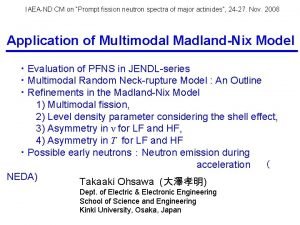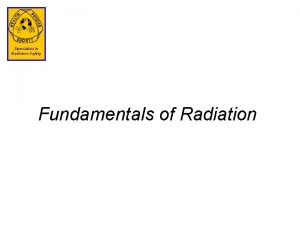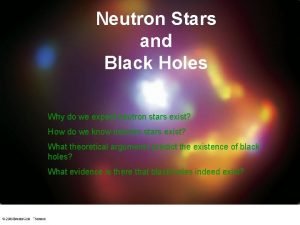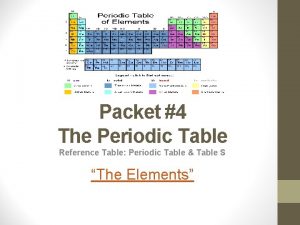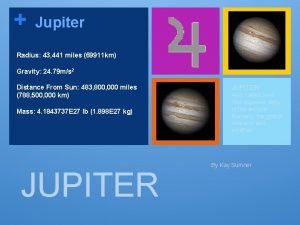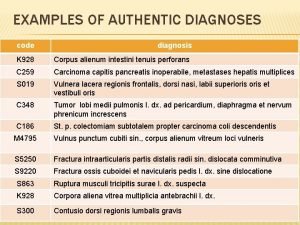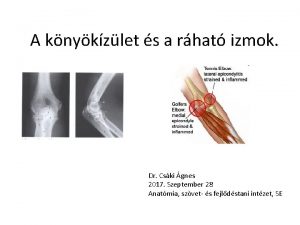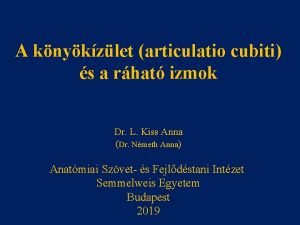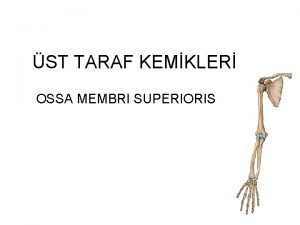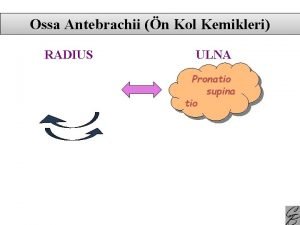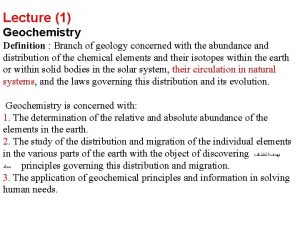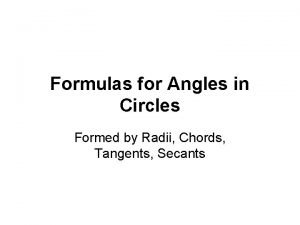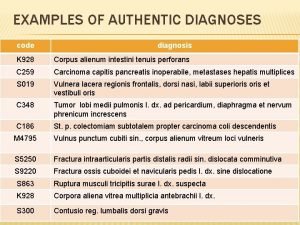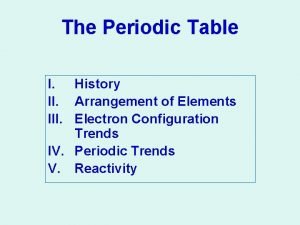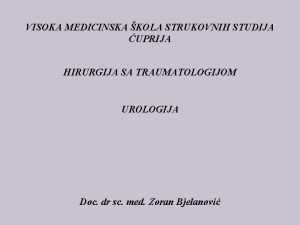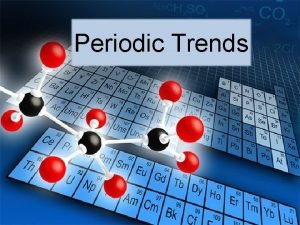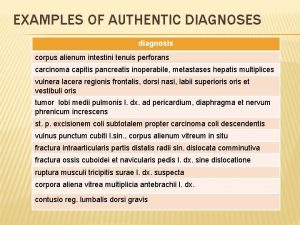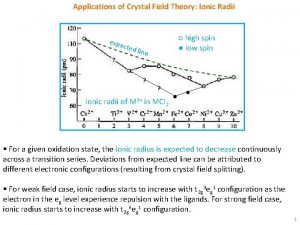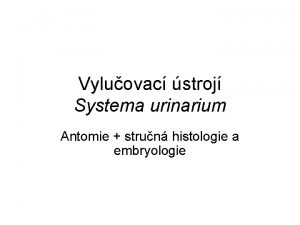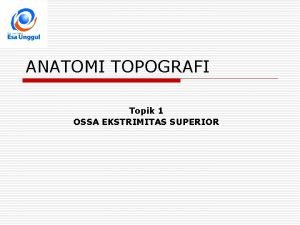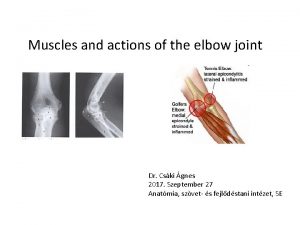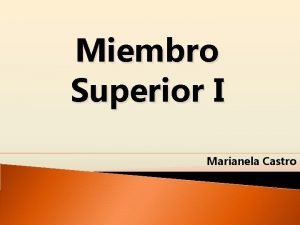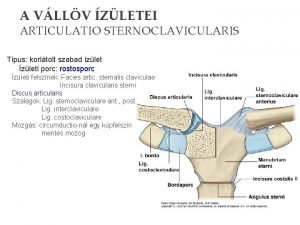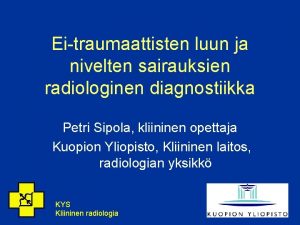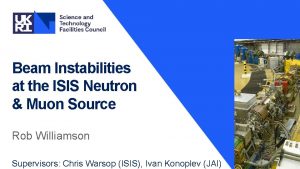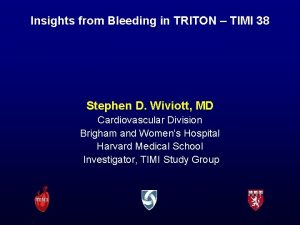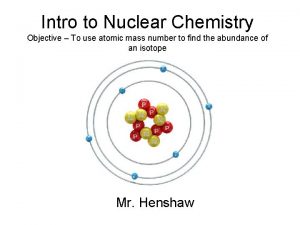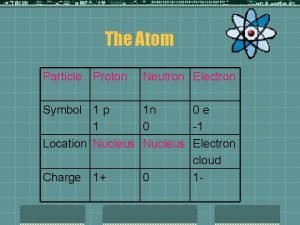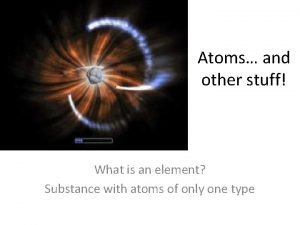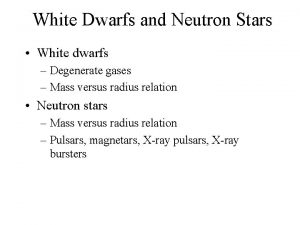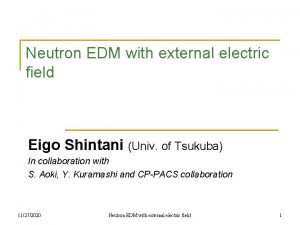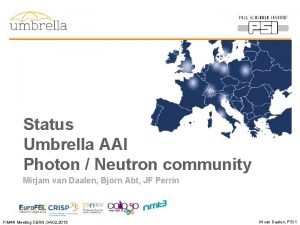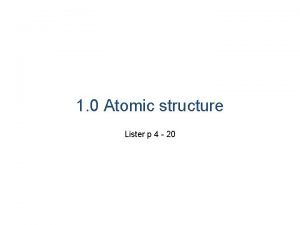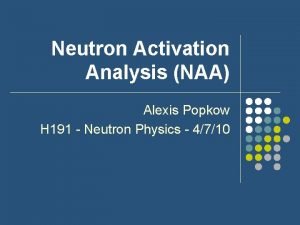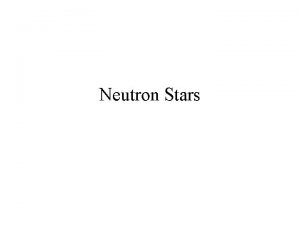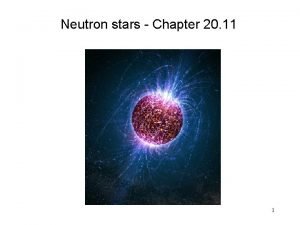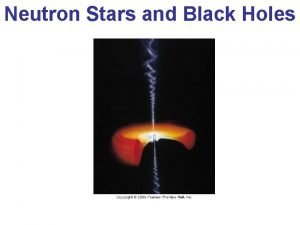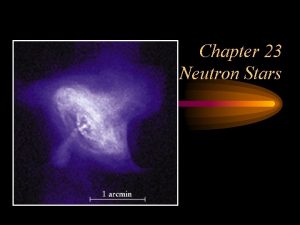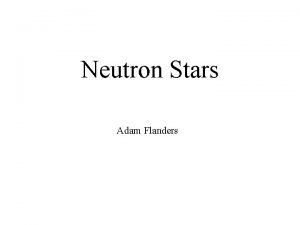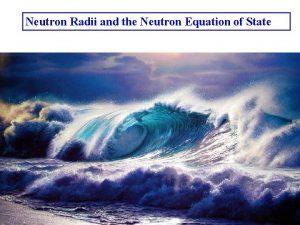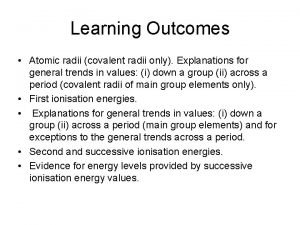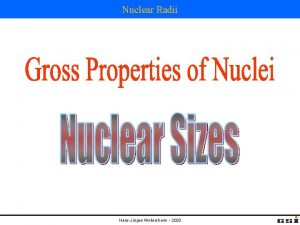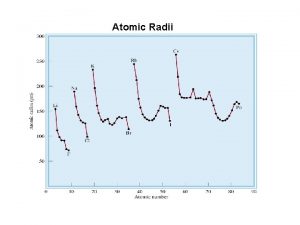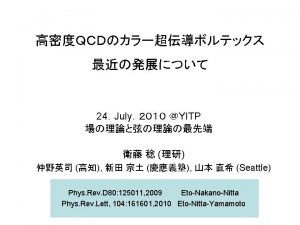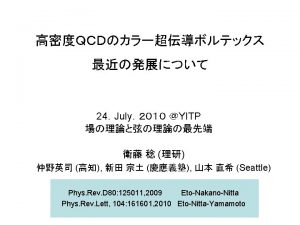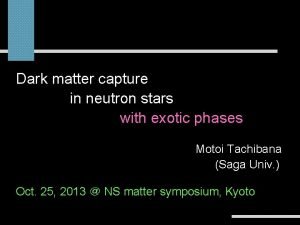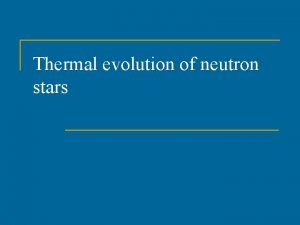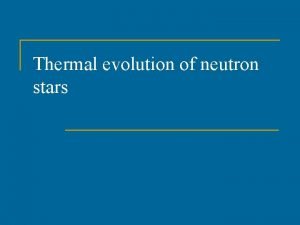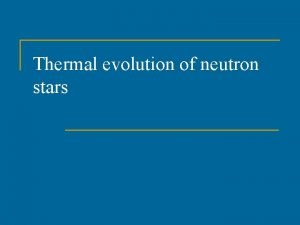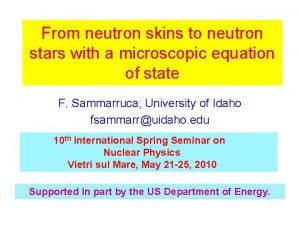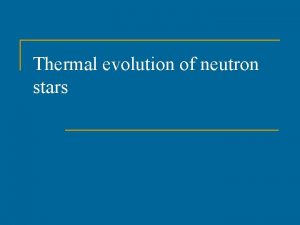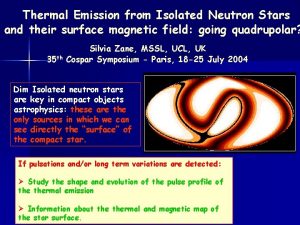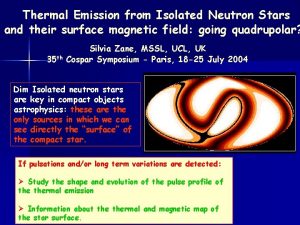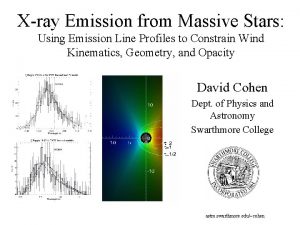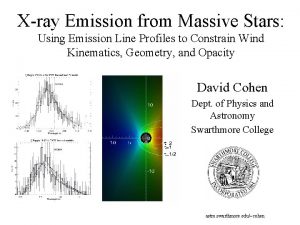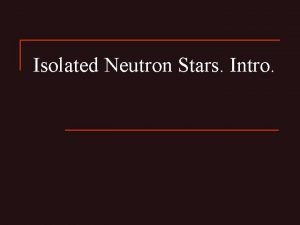Surface emission of neutron stars NS Radii n















































- Slides: 47

Surface emission of neutron stars

NS Radii n A NS with homogeneous surface temperature and local blackbody emission From dispersion measure From X-ray spectroscopy

NS Radii - II n Real life is a trifle more complicated… Atmospheres. n Because of the strong B field n n Photon propagation different Surface temperature is not homogeneous Local emission may be not exactly planckian Gravity effects are important

Uncertainties in temperature • Atmospheres (composition) • Magnetic field • Non-thermal contributions to the spectrum • Distance • Interstellar absorption • Temperature distribution (Pons et al. astro-ph/0107404)

Non-uniform temperature In the case of RX J 1856 distribution because of significant (~6) optical excess it was proposed that there is a spot, or there is a continuous temperature gradient. Trumper astro-ph/0502457

NS Thermal Maps n n n Electrons move much more easily along B than across B Thermal conduction is highly anisotropic inside a NS: Kpar >> Kperp until EF >> hνB or ρ >> 104(B/1012 G)3/2 g/cm 3 Envelope scaleheight L ≈ 10 m << R, B ~ const and heat transport locally 1 D Greenstein & Hartke (1983)

K - conductivity Valid for strong fields: Kperp << Kpar Core centered dipole Zane, Turolla astro-ph/0510693 Core centered quadrupole

Local Surface Emission n n Much like normal stars NSs are covered by an atmosphere Because of enormous surface gravity, g ≈ 1014 cm/s 2, hatm ≈ 1 -10 cm (hatm~k. T/mg) Spectra depend on g, chemical composition and magnetic field Plane-parallel approximation (locally)

Atmospheric composition A 1 The lightest As h<<R we can consider only flat layers. A 2 Light Due to strong gravity an atmosphere is expected to be separated: lighter elements on top. A 3 Heavy A 4 The heaviest g Because of that even a small amount of light elements (hydrogen) results in its dominance in the properties of the atmosphere. 10 -20 solar mass of hydrogen is enough to form a hydrogen atmosphere. See astro-ph/ 0702426

n Free-free absorption dominates n High energy photons decouple deeper in the atmosphere where T is higher Rapid decrease of the light-element opacities with energy (~E-3) Zavlin & Pavlov (2002) astro-ph/0206025

Emission from different atmospheres astro-ph/0702426

Fitting the spectrum of RX J 1856 Trumper astro-ph/0502457

Different fits Fits of realistic spectra of cooling NSs give higher temperature (and so smaller emitting surfaces) for blackbody and heavy element atmospheres (Fe, Si). TBB~2 TH Pons et al. 2002

Different fits Tbb~TFe>TH Pons et al. 2002

Cas A carbon atmosphere Low-field carbon atmosphere can fit the data. Before all fits provided a very small emitting area. 0911. 0672

Gravity Effects § Redshift § Ray bending

STEP 1 Specify viewing geometry and B-field topology; compute the surface temperature distribution STEP 2 Compute emission from every surface patch STEP 4 Predict lightcurve and phase-resolved spectrum Compare with observations STEP 3 GR ray-tracing to obtain the spectrum at infinity

The Seven X-ray dim Isolated NSs n n n n Soft thermal spectrum (k. T 50 -100 e. V) No hard, non-thermal tail Radio-quiet, no association with SNRs Low column density (NH 1020 cm-2) X-ray pulsations in all (but one? ) sources (P 3 -10 s) Very faint optical counterparts Broad spectral features

ICo. NS: The Perfect Neutron Stars ICo. NS are key in neutron star astrophysics: these are the only sources for which we have a “clean view” of the star surface n n n Information on thermal and magnetic surface distributions Estimate of the star radius (and mass ? ) Direct constraints on the EOS

ICo. NS: What Are They ? n n ICo. NS are neutron stars Idea number 1: Powered by ISM accretion? ṀBondi ~ n. ISM/v 3 if v < 40 km/s and D < 500 pc (e. g. Treves et al 2000) n n Measured proper motions imply v > 100 km/s Just cooling NSs

Simple Thermal Emitters ? Recent detailed observations of ICo. NS allow direct testing of surface emission models “STANDARD MODEL” thermal emission from the surface of a neutron star with a dipolar magnetic field and covered by an atmosphere The optical excess ICo. NS lightcurves The puzzle of RX J 1856. 5 -3754 Spectral evolution of RX J 0720. 4 -3125 Note a claim for an excess at harder (ke. V) X-rays: 1703. 05995

The Magnificent Seven Source k. T (e. V) P (s) Amplitude/2 Optical RX J 1856. 5 -3754 60 7. 06 1. 5% V = 25. 6 RX J 0720. 4 -3125 (*) 85 8. 39 11% B = 26. 6 RX J 0806. 4 -4123 96 11. 37 6% UV RX J 0420. 0 -5022 45 3. 45 13% B = 26. 6 RX J 1308. 6+2127 (RBS 1223) 86 10. 31 18% m 50 CCD = 28. 6 RX J 1605. 3+3249 (RBS 1556) 96 6. 88? ? ? m 50 CCD = 26. 8 104 9. 43 4% B=27. 4 1 RXS J 214303. 7+065419 (RBS 1774) (*) variable source

Featureless ? No Thanks ! RX J 0720. 4 -3125 (Haberl et al 2004) n RX J 1856. 5 -3754 is convincingly featureless (Chandra 500 ks DDT; Drake et al 2002; Burwitz et al 2003) n A broad absorption feature detected in all other ICo. NS (Haberl et al 2003, 2004 a; Van Kerkwijk et al 2004; Zane et al 2005) n n Eline ~ 300 -700 e. V; evidence for two lines with E 1 ~ 2 E 2 in RBS 1223 (Schwope et al 2006) Proton cyclotron lines ? H/He transitions at high B ?

Source Energy (e. V) EW (e. V) Bline (Bsd) (1013 G) Notes RX J 1856. 5 -3754 no no ? - RX J 0720. 4 -3125 270 40 5 (2) Variable line RX J 0806. 4 -4123 460 33 9 - RX J 0420. 0 -5022 330 43 7 - RX J 1308. 6+2127 300 150 6 (3) - RX J 1605. 3+3249 450 36 9 - 700 50 14 - 1 RXS J 214303. 7+065419

Non-uniform temperature distribution 1406. 0874

RX J 0806. 4 -412 BB+line Non-uniform distrubution 1406. 0874

Pulsating ICo. NS - I n n RX J 0420. 0 -5022 (Haberl et al 2004) Quite large pulsed fraction Skewed lightcurves Harder spectrum at pulse minimum Phase-dependent absorption features

Pulsating ICo. NS - II Core-centred dipole field Too small Too pulsed fractions pulsed Atmosphere Blackbody == + Symmetrical emission pulse profiles pulse (Zane 1995) & Turolla 2006) (Page + =

Crustal Magnetic Fields n Star centred dipole + poloidal/toroidal field in the envelope (Geppert, Küker & Page 2005; 2006) n n Purely poloidal crustal fields produce a steeper meridional temperature gradient Addition of a toroidal component introduces a N-S asymmetry Geppert, Küker & Page 2006 Gepper, Küker & Page 2006

Schwope et al. 2005 RBS 1223 (Zane & Turolla 2006) Indications for non-antipodal caps (Schwope et al 2005) Need for a non-axisymmetric treatment of heat transport

RX J 1856. 5 -3754 - I Blackbody featureless spectrum in the 0. 1 -2 ke. V band (Chandra 500 ks DDT, Drake et al 2002); possible broadband deviations in the XMM 60 ks observation (Burwitz et al 2003) RX J 1856 multiwavelength SED (Braje & Romani 2002) Thermal emission from NSs is not expected to be a featureless BB ! H, He spectra are featureless but only blackbody-like (harder). Heavy elements spectra are closer to BB but with a variety of features

RX J 1856. 5 -3754 - II What spectrum ? The optical excess ? A quark star (Drake et al 2002; Xu 2002; 2003) n A NS with hotter caps and cooler equatorial region (Pons et al 2002; Braje & n Romani 2002; Trűmper et al 2005) n A bare NS (Burwitz et al 2003; Turolla, Zane & Drake 2004; Van Adelsberg et al 2005; Perez. Azorin, Miralles & Pons 2005) A perfect BB ?

The Optical Excess n n n RX J 1605 multiwavelength SED (Motch et al 2005) In the most of the sources with a confirmed optical counterpart Fopt 5 -10 x B (TBB, X) Fopt 2 ? Deviations from a Rayleigh. Jeans continuum in RX J 0720 (Kaplan et al 2003) and RX J 1605 (Motch et al 2005). A non-thermal power law ?

Bare Neutron Stars n n At B >> B 0 ~ 2. 35 x 109 G atoms attain a cylindrical shape Turolla, Zane & Drake 2004 Formation of molecular chains by covalent bonding along the field direction RX J 0720. 4 -3125 Interactions between molecular chains can lead to the formation of a RX J 1856. 5 -3754 3 D condensate Critical Fe condensation H temperature depends on B and chemical composition (Lai & Salpeter 1997; Lai 2001)

Spectra from Bare NSs - I The cold electron gas approximation. Reduced emissivity expected below p (Lenzen & Trümper 1978; Brinkmann 1980) Spectra are very close to BB in shape in the 0. 1 - 2 ke. V range, but depressed wrt the BB at Teff. Reduction factor ~ 2 - 3. Turolla, Zane & Drake (2004)

Spectra from Bare NS - II Proper account for damping of free electrons by lattice interactions (e-phonon scattering; Yakovlev & Urpin 1980; Potekhin 1999) Spectra deviate more from BB. Fit in the 0. 1 – 2 ke. V band still acceptable. Features may be present. Reduction factors higher. Turolla, Zane & Drake (2004)

Is RX J 1856. 5 -3754 Bare ? n n n Fit of X-ray data in the 0. 15 -2 ke. V band acceptable Radiation radius problem eased Optical excess may be produced by reprocessing of surface radiation in a very rarefied atmosphere (Motch, Zavlin Does the atmosphere keep the star surface temperature ? Details of spectral shape (features, low-energy behaviour) still uncertain What is the ion contribution to the dielectric tensor ? & Haberl 2003; Zane, Turolla & Drake 2004; Ho et al. 2006) n (Van Adelsberg et al. 2005; Perez-Azorin, Miralles & Pons 2005)

Condensed iron surface emissivity Free ions approximation. 1006. 3292

Thin hydrogen magnetized atmosphere above blackbody and iron condensed surface Below atmosphere was a blackbody spectrum 1006. 3292 Below – iron condensed surface

Let us make it realistic Naked iron surface 1006. 3292

Light curves and pulsed fraction 1010. 0125 1006. 3292

Low-field magnetar SGR Fitting parameters of the magnetized atmosphere it is possible to show, 0418+5729 that the low-field solution is not acceptable. This can be due to non-dipolar field components. New results in 1507. 02689 1103. 3024

Phase-resolved spectra and RX J 1308. 6+2127 Afeatures feature at the energy of ∼ 740 e. V and an equivalent width of ∼ 15 e. V 1703. 05336

Conclusions • Emission from cooling NSs is more complicated than a simple blackbody • Light bending (gravity) • Atmospheres • Magnetic field distribution - effects on properties of atmospheres and emission • Magnetic field (including toroidal) in the crust – non-uniform temp. distr. • Condensate • Rotation at ~msec periods can smear spectral lines

Papers to read • • • astro-ph/0702426 ar. Xiv: 0801. 1143 Reviews on the M 7 or astro-ph/0609066 astro-ph/0206025 ar. Xiv: 0905. 3276 Recent calculations of spectra from magnetized atmos. ar. Xiv: 1006. 3292 ar. Xiv: 1210. 0916 - review

All in optics and UV All seven objects have confirmed optical and ultraviolet counterparts. The Rayleigh-Jeans tail would be flat. The best-fit power-laws with ± 1σ uncertainties are shown by the cyan lines. The extrapolations of the X-ray blackbodies with ± 1 σ uncertainties are shown by the magenta lines. k. T New data: Kaplan et al. 1105. 4178

Is RX J 1856. 5 -3754 Bare ? n n n Fit of X-ray data in the 0. 15 -2 ke. V band acceptable Radiation radius problem eased Optical excess may be produced by reprocessing of surface radiation in a very rarefied atmosphere (Motch, Zavlin & Haberl 2003; Zane, Turolla & Drake 2004; Ho et al. 2006) n Details of spectral shape (features, low-energy behaviour) still uncertain Does the atmosphere keep the star surface temperature ?
 Activity formula
Activity formula Actinides
Actinides Neutron emission
Neutron emission How are neutron stars formed
How are neutron stars formed The rwenzori mountains mary daniels is a student in england
The rwenzori mountains mary daniels is a student in england Periodic table radius
Periodic table radius Periodic table reference table
Periodic table reference table 43 441 mi to km
43 441 mi to km Vulnus reg mentalis
Vulnus reg mentalis Circle terminology
Circle terminology Supinatio
Supinatio Art radioulnaris proximalis
Art radioulnaris proximalis Cingulum membri superioris kemikleri
Cingulum membri superioris kemikleri Ionization energy
Ionization energy N kol
N kol Geochemistry definition
Geochemistry definition Secant tangent
Secant tangent Phrenicum
Phrenicum Vfi atomic radii
Vfi atomic radii Nephrostomia
Nephrostomia Atomic radius trend
Atomic radius trend Atomic radius of elements
Atomic radius of elements Luksacija lakta
Luksacija lakta Diagnosis corpus alienum
Diagnosis corpus alienum Applications of cft
Applications of cft Polvilumpion murtuma toipuminen
Polvilumpion murtuma toipuminen Five rods
Five rods Radii medullares
Radii medullares Corpus humerus
Corpus humerus Radioulnar joint
Radioulnar joint Cavidad glenoidea
Cavidad glenoidea Fleksija lakta
Fleksija lakta Faller
Faller Rasitusmurtuma ranteessa
Rasitusmurtuma ranteessa Lateral and total surface area
Lateral and total surface area Spin coat
Spin coat Wet curved surface area
Wet curved surface area Isis neutron and muon source
Isis neutron and muon source Timi neutron
Timi neutron Chlorine neutron
Chlorine neutron How to find the number of protons and neutrons
How to find the number of protons and neutrons Symbole proton neutron electron
Symbole proton neutron electron Hydrogen isotope with 1 neutron
Hydrogen isotope with 1 neutron Angular momentum
Angular momentum Neutron
Neutron Photon neutron
Photon neutron No of protons in lithium
No of protons in lithium Neutron activation analysis
Neutron activation analysis

